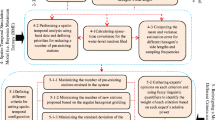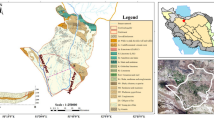Abstract
Assessment of groundwater quality monitoring networks requires methods to determine the potential efficiency and cost-effectiveness of the current monitoring programs. To this end, the concept of entropy has been considered as a promising method in previous studies since it quantitatively measures the information produced by a network. In this study, the measure of transinformation in the discrete entropy theory and the transinformation–distance (T–D) curves, which are used frequently by other researchers, are used to quantify the efficiency of a monitoring network. This paper introduces a new approach to decrease dispersion in results by performing cluster analysis that uses fuzzy equivalence relations. As a result, the sampling (temporal) frequency determination method also recommends the future sampling frequencies for each location based on certain criteria such as direction, magnitude, correlation with neighboring stations, and uncertainty of the concentration trend derived from representative historical concentration data. The proposed methodology is applied to groundwater resources in the Tehran–Karadj aquifer, Tehran, Iran.
Similar content being viewed by others
References
Abrishamchi, A., Owlia, R. R., Tajrishi, M., & Abrishamchi, A. (2008). Optimal design of groundwater quality monitoring using entropy theory. In: Proceedings of the conference on water scarcity, climate change and groundwater management responses, California, U.S.A., 1–5 December 2008.
Bueso, M. C., Angulo, J. M., Cruz-Sanjulian, J., & Carcia-Arostegui, J. L. (1999). Optimal spatial sampling design in a multivariate framework. Mathematical Geology, 31(5), 507–525.
Dhar, A., & Datta, B. (2007). Multiobjective design of dynamic monitoring for detection of groundwater pollution. Journal of Water Resources Management, 133(4), 329–338.
Granato, G. E., & Smith, K. P. (1999). Robowell: An automated process for monitoring ground water quality using established sampling protocols. Ground Water Monitoring and Remediation, 19(4), 81–89.
Harmancioglu, N. B., Fistikoglu, O., Ozkul, S. D., Singh, V. P., & Alpaslan, N. (1999). Water quality monitoring network design (290 pp.). Boston, MA: Kluwer.
Husain, T. (1989). Hydrologic uncertainty measure and network design. Water Resources Bulletin, 25(3), 527–534.
Jager, H. I., Sale, M. J., & Schmayer, R. L. (1990). Cokriging to assess regional stream quality in the Southern Blue Ridge Province. Water Resources Research, 26(7), 1401–1412.
Karamouz, M., Khajehzadeh Nokhandan, A., Kerachian, R., & Maksimovic, C. (2008). Design of on-line river water quality monitoring systems using the entropy theory: A case study. Environmental Monitoring and Assessment, 155(1–4), 63–81.
Khan, F. I., & Husain, T. (2004). An overview and analysis of site remediation technologies. Journal of Environmental Management, 71, 95–122.
Koorehpazan Dezfuli, A. (2005). Fuzzy set theory and its application in the modeling of water engineering problems (pp. 32–73). Tehran, Iran: Jahad Daneshgahi Publication (in Persian).
Ling, M., Rifai, H. S., Newell, C. J., Aziz, J. J., & Gonzales, J. R. (2003). Groundwater monitoring plans at small scale sites—An innovative spatial and temporal methodology. Journal of Environmental Monitoring and Assessment, 5, 126–134.
Loaiciga, H. A., Charbeneau, R. J., Everett, L. G., Fogg, G. E., Hobbs, B. F., & Rouhani, S. (1992). Review of ground-water quality monitoring network design. Journal of Hydraulic Engineering, 118(1), 11–37.
Mahar, P. S., & Datta, B. (1997). Optimal monitoring and groundwater pollution source identification. Journal of Water Resources Planning and Management, 123(4), 199–207.
Masoumi, F., & Kerachian, R. (2007). Optimal groundwater monitoring network design using entropy theory. In: Proceedings of conference on water management, Malaysia, 14–16 May 2007.
Masoumi, F., & Kerachian, R. (2008). Optimal redesign of groundwater quality monitoring networks: A case study. Environmental Monitoring and Assessment, 161(1), 247–257.
Mogheir, Y. (2003). Assessment and redesign of groundwater quality monitoring networks using the entropy theory—Gaza Strip case study. Ph.D. thesis, Coimbra University, Portugal.
Mogheir, Y., Lima, J. L. M. P., & Singh, V. P. (2003). Spatial structure assessment of groundwater quality variables based on the entropy theory. Hydrology and Earth System Sciences, 7(5), 707–721.
Mogheir, Y., Lima, J. L. M. P., & Singh, V. P. (2004). Characterizing the spatial variability of groundwater quality using the entropy theory: I. Case study from Gaza Strip. Hydrological Processes, 18, 2165–2179.
Mogheir, Y., & Singh, V. P. (2002). Application of information theory to groundwater quality monitoring networks. Water Resources Management, 16(1), 37–49.
Motulsky, H. J., & Christopoulos, A. (2008). Fitting models to biological data using linear and nonlinear regression. A practical guide to curve fitting. San Diego, CA: GraphPad Software Inc. http://www.graphpad.com.
Owlia, R. R., Hoseini, F., & Abrishamch, A. (2009). New approach for design of groundwater quality monitoring network using entropy theory. In: Proceedings of 7th international conference on water resources conservation and risk reduction under climatic instability, Limassol, Cyprus, 25–27 June 2009.
Ozkul, S., Harmancioglu, N. B., & Singh, V. P. (2000). Entropy-based assessment of water quality monitoring networks. Journal of Hydrologic Engineering, ASCE, 5(1), 90–100.
Prakash, M. R., & Singh, V. S. (2000). Network design for groundwater monitoring—A case study. Journal of Environmental Geology, 39(6), 628–632.
Reed, P. M. (1997). Cost effectiveness long term groundwater monitoring design using a genetic algorithm and global mass interpolation. M.Sc. thesis, University of Illinois at Urbana-Champaign, U.S.A.
Reed, P. M., & Minsker, B. S. (2004). Striking the balance: Long term monitoring design for conflicting objectives. Journal of Water Resources Planning and Management, 130(2), 140–149.
Ren, X., & Minsker, B. (2005). Which groundwater remediation objective is better: A realistic one or a simple one? Journal of Water Resources Planning and Management, 131(5), 351–361.
Sanders, T. G., Ward, R. C., Loftis, J. C., Steele, T. D., Adrian, D. D., & Yevjevich, V. (1983). Design of networks for monitoring water quality (Vol. 14, pp. 569–576). Littleton, CO: Water Resources Publications.
Sarlak, N., & Sorman, A. U. (2006). Evaluation and selection of stream flow network stations using entropy methods. Turkish Journal of Engineering and Environmental Sciences, 30, 91–100.
Shannon, C. E. (1948). A mathematical theory of communication. Bell System Technical Journal, 27, 379–423.
Singh, V. P. (1997). The use of entropy in hydrology and water resources. Hydrological Processes, 11, 587–626.
Singh, V. P. (1998). Entropy-based parameter estimation in hydrology. Boston, MA: Kluwer Academic Publishers.
Strobel, R. O., & Robillard, P. D. (2007). Network design for water quality monitoring of surface freshwater: A review. Journal of Environmental Management. doi:10.1016/j.jenvman.
Tuckfield, R. C. (1993). Estimation an appropriate sampling frequency for monitoring groundwater well contamination. DOE Contract No. DE-AC09-89SR18035, International Nuclear Materials Management Annual Meeting, Westinghouse Savannah River Company, Savannah River Site, Naples.
U.S. EPA (1999). Use of monitored natural attenuation at superfund, rcra corrective action, and underground storage tank site. Directive 9200.4-17P, Final Draft, U.S. Environmental Protection Agency, Office of Solid Waste and Emergency Response, p. 23.
Ward, R. C., & Loftis, J. C. (1986). Establishing statistical design criteria for water quality monitoring systems: Review and synthesis. Water Resources Bulletin, 22(5), 759–767.
Yang, Y., & Burn, D. (1994). An entropy approach to data collection network design. Journal of Hydrology, 157, 307–324.
Zhou, Y. (1995). Sampling frequency for monitoring the actual state of groundwater systems. Journal of Hydrology, 180(1–4), 301–318.
Author information
Authors and Affiliations
Corresponding author
Rights and permissions
About this article
Cite this article
Owlia, R.R., Abrishamchi, A. & Tajrishy, M. Spatial–temporal assessment and redesign of groundwater quality monitoring network: a case study. Environ Monit Assess 172, 263–273 (2011). https://doi.org/10.1007/s10661-010-1332-8
Received:
Accepted:
Published:
Issue Date:
DOI: https://doi.org/10.1007/s10661-010-1332-8




